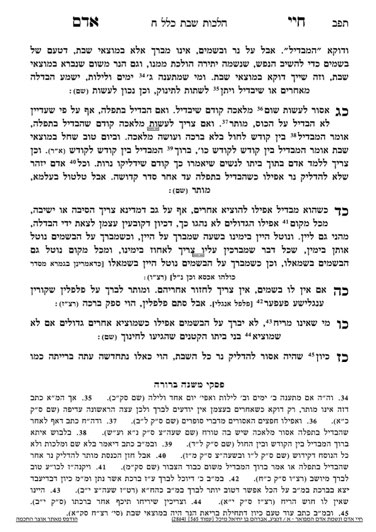We are beginning siman 24, where the Chayei Adam discusses the proper procedure for havdalah. On the one hand, it can be argued that one should stand, because it is more appropriate to stand when escorting out the Shabbos Queen. On the other hand, it can be argued that one should sit, because being motzi someone else requires both parties in a state of functioning together as a unit. This requires an element of kvius, that they are establishing themselves. Chazal tell us that one of the strongest ways to establish kvius is to be sitting together. At the time of Chazal, kvius was defined as haseivah (lying down on couches), but since we no longer practice haseivah, our sitting is the equivalent.
The Shulchan Aruch writes (siman 296) that havdalah should be recited when one is seated. The Rema states that one should stand, and states that it is the minhag in the Ashkenazi kehillos. The issue of kvius is addressed by ensuring that everyone is standing together and not wandering around while havdalah is recited.
The one exception is Motzei Shabbos going into Yom Tov, where havdalah is made as part of the special yakneha”z kiddush. The Mishnah Berurah writes that everyone agrees it is preferable to sit, because since kiddush is recited seated, havdalah should be recited while seated as well.
Thus, the Chayei Adam writes that when one makes havdalah, even if they are being motzi others, they should stand. Even though generally when being motzi others one needs to sit, and in the times of Chazal, they needed to perform haseivah, the minhag is to stand. The Chayei Adam writes that the gedolim of the Ashkenazi world would stand. The kvius of people standing is sufficient for havdalah and for the hagafen on the wine.
We have learned (shiur S160) that, technically speaking, shomeah k’oneh could work without kvius. However, Chazal created various limitations as to when shomeah k’oneh works. For example, one cannot be motzi another in shemoneh esrei unless there are 10 people, to be motzi another in a bracha on food requires the people to be seated, and there must be a zimun in order to be motzi someone in birchas hamazon. Thus, we understand how Chazal could decide that it is appropriate not to place their requirement of being seated on havdalah in order to gain the benefit of escorting the Shabbos King.
Practically, there are different minhagim. The minhag in Telshe Yeshiva was to say havdalah standing. The Mosif Dirshu Mishnah Berurah brings that the Chofetz Chaim recited havdalah standing, but the Chazon Ish and Steipler recited havdalah when seated.
Summary
- The Shulchan Aruch writes that one should sit for havdalah, but the Rema writes one should stand. One should follow their minhag.



